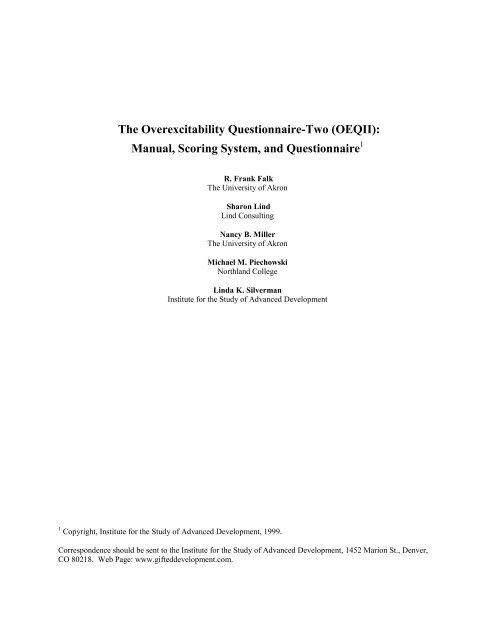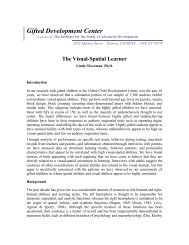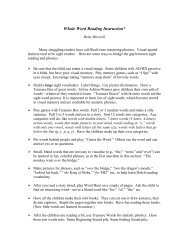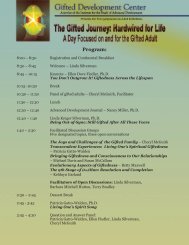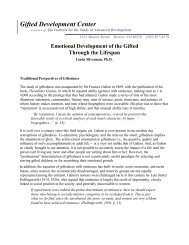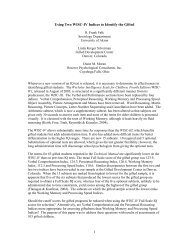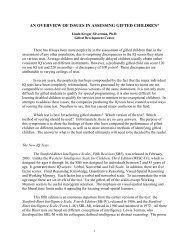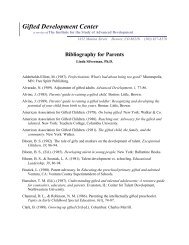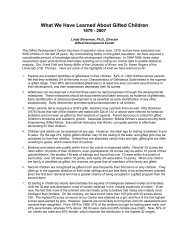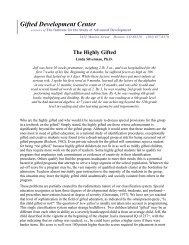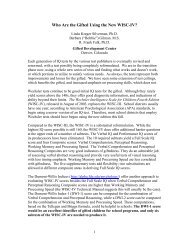The Overexcitability Questionnaire-Two (OEQII): Manual, Scoring ...
The Overexcitability Questionnaire-Two (OEQII): Manual, Scoring ...
The Overexcitability Questionnaire-Two (OEQII): Manual, Scoring ...
- No tags were found...
You also want an ePaper? Increase the reach of your titles
YUMPU automatically turns print PDFs into web optimized ePapers that Google loves.
<strong>The</strong> <strong>Overexcitability</strong> <strong>Questionnaire</strong>-<strong>Two</strong> (<strong>OEQII</strong>):<strong>Manual</strong>, <strong>Scoring</strong> System, and <strong>Questionnaire</strong> 1R. Frank Falk<strong>The</strong> University of AkronSharon LindLind ConsultingNancy B. Miller<strong>The</strong> University of AkronMichael M. PiechowskiNorthland CollegeLinda K. SilvermanInstitute for the Study of Advanced Development1 Copyright, Institute for the Study of Advanced Development, 1999.Correspondence should be sent to the Institute for the Study of Advanced Development, 1452 Marion St., Denver,CO 80218. Web Page: www.gifteddevelopment.com.
IntroductionThis manual describes the development, testing, and scoring of a new questionnaire to measureoverexcitability (OE). <strong>Overexcitability</strong> is a basic concept in Dabrowski’s theory of positive disintegration. Itconsists of five dimensions--psychomotor, sensual, imaginational, intellectual and emotional. “<strong>The</strong> <strong>Overexcitability</strong><strong>Questionnaire</strong>-<strong>Two</strong>” (<strong>OEQII</strong>) represents a new research instrument for those interested in an easily administered andscored version. A five-point Likert scale is used for item response. This version is for research with group dataand is not intended to provide diagnostic information about an individual.<strong>Overexcitability</strong> (Dabrowski, Kawczak, & Piechowski, 1970) is an English translation of the Polish word“nadpobudliwosc,” whose direct translation is “superstimulation.” In the past, synonyms included overexcitabilityand hyperexcitability. Various ways of assessing the overexcitabilities (OEs) have been used over the yearsincluding responses to deep reflex stimulation, open-ended responses to verbal stimuli, assessment inautobiographical material (Dabrowski & Piechowski, 1977; Piechowski, 1975), and an open-ended questionnaire(e.g., Falk, Manzanero, & Miller, 1997; Falk, Piechowski, & Lind, 1994; Lysy & Piechowski, 1983; Miller,Silverman, & Falk, 1992; Piechowski, 1979).<strong>The</strong>se approaches require sophisticated coding systems and well-trained coders to analyze the collecteddata. <strong>The</strong>se earlier procedures provided rich detail about individual characteristics and individual differences. Forlarge scale research projects, however, these techniques were unwieldy. To facilitate research, several investigatorswere interested in creating an easily administered and scored research instrument. This led to the development of anobjective form, the <strong>OEQII</strong>.History of the Development of the ItemsOver the last ten years there have been various attempts to create a more easily scored research assessmenttool. Those earlier attempts never yielded a satisfactory questionnaire. To begin the development of the OEQ-II,colleagues familiar with overexcitabilities and the theory of positive disintegration were contacted for eitherpublished or unpublished information, which might be a source of questionnaire items. Michael Piechowski draftedinventories of “Thinking Style” and of “Emotional Style” based on items he and Clive Hazell synthesized fromactual responses to early OE <strong>Questionnaire</strong>s. A questionnaire developed by the Emotional Development StudyGroup at the University of Denver (Ammirato, 1987) provided initial sources of questions. <strong>The</strong> A.I.M.<strong>Questionnaire</strong> (Larsen, Diener, & Emmons, 1986) and the Wilson-Barber Inventory of Childhood Memories andImaginings (Myers, 1983) supported the theoretical constructs and suggested some fresh approaches. In addition,new items were developed by a team of experts on Dabrowski’s theory.Because additional items were still needed, Sharon Lind examined more than 300 previously completedOEQs. Using the initial work of Piechowski and Hazell as a model, items were created from the actual responses orthemes found in the responses of prior subjects. This process required several months to complete and yielded 140items. After critique by the authors 124 items remained. <strong>The</strong>se items were reworded to include both positively andnegatively phrased descriptors and to ensure that an 8 th grade reading level was maintained. Items were randomizedand placed in a 5-point rating scale format. <strong>The</strong> final descriptions for the rating were: Not at All Like Me for thelowest level (1), Not Much Like Me (2), Somewhat Like Me (3), A Lot Like Me (4), and Very Much Like Me (5).Methodology<strong>The</strong> final 124 items were administered to 563 college students at a large Midwestern university. Most ofthese students were in a general education course that fulfills a general social science requirement. <strong>The</strong> sampleincluded 64% females and 36% males with a wide age range (15 to 62 years of age); however, 65% of subjects werebetween 18 and 21 years of age. <strong>The</strong> racial composition resembled the population of the university with 78.3%white or European ethnic, 16.3% African-American, and 5.4% reporting other racial categories. Eighty-nine percentwere single; 88% were full-time college students (Bouchet, 1998).
An additional sample was generated by researchers from the United States and Canada who had access toyounger and older subjects. This resulted in 324 questionnaires from subjects with an age range from 10 to 76.Forty-nine percent of these subjects were 17 years of age or younger. Sixty-eight percent of this sample werefemales and 32% were males. Thirty-five percent were high school students, 22% were in middle school, and 16%were undergraduate college students. Sixty-five percent of the sample participated in gifted, talented, or honorseducational programs.An initial principal components factor analysis with varimax rotation was conducted using the StatisticalPackage for the Social Sciences (SPSS) on the first sample (Falk & Lind, 1998). This analysis was repeated withthe second sample which replicated the first analysis with only minor item fluctuations (Kort-Butler & Falk, 1999).Based on these results, the two samples were combined and a final stable factor structure was found.A 5-factor simple structure was obtained from the 124 items with a combined sample of 887 subjects. <strong>The</strong>5 factors were conceptually clear and theoretically relevant. <strong>The</strong> first 10 items on each factor had loadings above .5.Each of the 5 factors, of 10 items each, could easily be named by one of the overexcitabilities.Cronbach’s alpha was used to examine the internal reliability, which is a measure of consistency among the10 items. This coefficient has a theoretical range of 0 to 1 where 1 represents perfect internal consistency. An alphaabove .80 is interpreted as high scale reliability. <strong>The</strong> alpha coefficients for the 5 factors are: Psychomotor = .86,Sensual = .89, Imaginational = .85, Intellectual = .89, and Emotional = .84.With the internal consistency established, the 10 items for each factor can be added to establish a score foreach overexcitability. <strong>The</strong> scores for all subjects were calculated by adding the 10 items for each factor. Since eachquestion can have a score from 1 to 5, the total score for the 10 items was divided by 10, the number of items in eachscale.Results<strong>The</strong> descriptive statistics for each factor for this sample are presented in Table 1. Of the 887 subjects in thestudy, 852 answered all 50 questions representing an item response rate of 96% listwise. Thus, the questions have agood response rate with most subjects being able to provide an answer to all of the questions. Eight hundredseventy-two subjects or 98% answered all 10 items for intellectual OE, and 879 subjects or 99% answered all 10items for emotional OE. <strong>The</strong> minimum number of missing cases for the 5 factors was 8, for emotional OE, and themaximum was 15, for intellectual OE.Table 1Descriptive Statistics for Overexcitabilities<strong>Overexcitability</strong> N Minimum Maximum Mean SD SkewnessPsychomotor 875 1.20 5.00 3.35 0.79 -.11Sensual 876 1.10 5.00 3.28 0.87 -.06Imaginational 876 1.00 5.00 2.86 0.83 .19Intellectual 872 1.30 5.00 3.50 0.79 -.15Emotional 879 1.30 5.00 3.72 0.77 -.45Valid N (listwise) 852<strong>The</strong> minimum and maximum values suggest that the full range of scores (1 to 5) was obtained across thestudy. Imaginational and sensual OEs had the lowest minimum scores of 1.00 and 1.10 respectively.<strong>The</strong> means are centered near the middle of the scale, a value of 3. Emotional had the highest mean (3.72)and Imaginational had the lowest mean (2.86). Standard deviations around the means are relatively small.3
<strong>The</strong> skewness of a variable indicates whether the responses represent a normal distribution or bell shapedcurve. In all cases, except emotional, the curves are bell shaped. Emotional is only slightly skewed with more scoresin the higher range than in the lower. This is also reflected in the fact that the minimum score and the mean scorefor emotional OE are higher than those of any of the other overexcitabilities.<strong>The</strong> quartile scores for the 5 OE’s are given in Table 2. <strong>The</strong> 50 th percentile represents the median. <strong>The</strong>lowest 25 percent of the subjects scored at or below the 25 th percentile while the highest 25 percent of the subjectsscored at or above the 75 th percentile.<strong>Overexcitability</strong>Table 2Quartile Scores for the OverexcitabilitiesPercentiles25th 50th 75thPsychomotor 2.80 3.40 3.90Sensual 2.60 3.30 4.00Imaginational 2.30 2.80 3.50Intellectual 2.80 3.40 4.00Emotional 3.20 3.80 4.30Conclusion<strong>The</strong> 10 items measuring each of the 5 OEs have high reliability, good content validity, andpresent simple factor structures. <strong>The</strong> summed items on each factor produce a normal Q-Q plotdemonstrating that they represent a nearly normal distribution scale score. <strong>The</strong> means of each scale arelocated in the middle of the 1 to 5 scale; standard deviations are relatively small. <strong>The</strong> items are seen asrelevant and answerable by the subjects as indicated by the large N size of valid responses for each OE.<strong>The</strong> questionnaire was written for an 8 th grade reading level. Subjects having a reading ability atthis level should be able to complete the questionnaire. In fact, 71 subjects in our combined sample werein middle school, grades 6 through 8, and 2 students were in elementary school. <strong>The</strong> youngest subject in thesample was 10 years of age and an identified gifted student.<strong>The</strong> interpretation of the scores for any one individual has yet to be established. We havecomputed the quartile scores for each OE based on this rather large sample of nearly 900 subjects. Butdoes the median, 50 th percentile value, indicate overexcitability? What percentage of the population isoverexcitable? Since no subject can score below 1 on the <strong>OEQII</strong>, it is not possible to define the conditionof no overexcitability, based on the numbers provided by the scale. Perhaps we can say that someonewho scores in the 75 th percentile is clearly overexcitable, but these interpretations will require furtherresearch. From a research point of view, we can conclude that one group of subjects scores higher orlower than another group. We can also discuss the correlations and predictions of other variables with ourmeasurements of OE. <strong>The</strong>refore, the <strong>OEQII</strong> may be used for research with group data but cannot providediagnostic information about the individual.<strong>The</strong> <strong>OEQII</strong> is an equal-appearing interval measure and represents an ordered-metric scale(Blalock, 1972). Parametric statistical analysis is deemed appropriate.4
<strong>Scoring</strong> ProcedureTo get a total score for each OE, 10 items are summed . Some items require reverse scoringwhere 1 becomes 5 and 5 becomes 1, 2 becomes 4 and 4 becomes 2, and 3 does not change. Of theoriginal 21 reverse-scored items, only 2 remain in the final version of the <strong>OEQII</strong>. <strong>The</strong> total score of eachOE is divided by 10, the total number of questions, to maintain the scale of 1 to 5.Compute the scores as follows:<strong>The</strong> Psychomotor OE score is obtained by (a) adding items 2, 7, 10, 15, 18, 21,29, 39, 42, 50; and (b) dividing by 10.<strong>The</strong> Sensual OE score is obtained by (a) reverse scoring item 38; (b) addingitems 3, 8, 13, 27, 32, 37, 38, 45, 46, 48; and (c) dividing by 10.<strong>The</strong> Imaginational OE score is obtained by (a) adding items 1, 4, 14, 20, 22, 24,28, 33, 34, 47; and (b) dividing by 10.<strong>The</strong> Intellectual OE score is obtained by (a) adding items 5, 12, 16, 19, 23, 25,30, 36, 40, 43; and (b) dividing by 10.<strong>The</strong> Emotional OE score is obtained by (a) reverse scoring item 44; (b) addingitems 6, 9, 11, 17, 26, 31, 35, 41, 44, 49; and (c) dividing by 10.5
ReferencesAmmirato, S. P. (1987). Comparison study of instruments used to measure developmental potentialaccording to Dabrowski’s theory of emotional development. Unpublished doctoral dissertation,University of Denver, Denver, CO.Blalock, H. M. (1972). Social statistics. New York: McGraw-Hill.Bouchet, N. M. (1998). <strong>The</strong> relationship between social structure and personality: Explicating thesecond factor in Dabrowski’s <strong>The</strong>ory of Emotional Development. Unpublished master’s thesis,University of Akron, Akron, OH.Dabrowski, K., Kawczak, A., & Piechowski, M. M. (1970). Mental growth through positivedisintegration. London, England: Gryf.Dabrowski, K., & Piechowski, M. M. (1977). <strong>The</strong>ory of levels of emotional development: Vol. 2. Fromprimary integration to self-actualization. Oceanside, NJ: Dabor Science.Falk, R. F. & Lind, S. (1988). <strong>The</strong> overexcitability questionnaire <strong>OEQII</strong>: Development and testing. Paperpresented at the third international Dabrowski symposium, Evanston, IL.Falk, R. F., Manzanero, J. B., & Miller, N. B. (1997). Developmental potential in Venezuelan andAmerican artists: A cross-cultural validity study. <strong>The</strong> Creativity Research Journal 10, 201-206.Falk, R. F., Piechowski, M. M., & Lind, S. (1994). Criteria for rating the intensity of overexcitabilities.Unpublished manual, Sociology Department, University of Akron.Kort-Butler, L., & Falk, R. F. (1999). Replicating a factor structure from two samples: Art and science.Paper presented at the meeting of the North Central Sociological Association, Flint, MI.Larsen, R. J., Diener, E., & Emmons R. A. (1986). Affect intensity and reactions to daily life events.Journal of Personality and Social Psychology, 51, 803-814.Lysy, K. Z., & Piechowski, M. M. (1983). Personal growth: An empirical study using Jungian andDabrowskian measures. Genetic Psychology Monographs, 108, 267-320.Miller, N. B., Silverman, L. K., & Falk, R. F. Emotional development, intellectual ability, and gender.Journal for the Education of the Gifted, 18, 20-38.Myers, S.A. (1983). <strong>The</strong> Wilson-Barber Inventory of Childhood Memories and Imaginings: Children'sforms and norms for 1337 children and adolescents. Journal of Mental Imagery, 7, 83-94.Piechowski, M. M. (1975). A theoretical and empirical approach to the study of development. GeneticPsychology Monographs, 92, 231-297.Piechowski, M. M. (1979). Developmental potential. In N. Colangelo and R. T. Zaffrann (Eds.), NewVoices in Counseling the Gifted (pp. 25-57). Dubuque, IA: Kendall/Hunt.6
OEQ II Inventory 1Directions: Please rate how much each statement fits you. Respond on the basis of what you are likenow, not how you would like to be or how you think you should be. Circle the number under thestatement that most accurately reflects the way you see yourself.Not at Not Some- A VeryAll Much what Lot MuchLike Like Like Like LikeMe Me Me Me Me1. I like to daydream. . . . . . . . . . . . . . . . . . . . . . . . . . . . . . . . . . . . . . 1 2 3 4 52. I am a competitive person. . . . . . . . . . . . . . . . . . . . . . . . . . . . . . . . 1 2 3 4 53. <strong>The</strong> varieties of sound and color are delightful. . . . . . . . . . . . . . . 1 2 3 4 54. My pretend world is very real to me. . . . . . . . . . . . . . . . . . . . . . . . 1 2 3 4 55. I am an independent thinker. . . . . . . . . . . . . . . . . . . . . . . . . . . . . . 1 2 3 4 56. I feel other people’s feelings . . . . . . . . . . . . . . . . . . . . . . . . . . . . . 1 2 3 4 57. If an activity is physically exhausting, I find it satisfying . . . . . . . 1 2 3 4 58. Viewing art is a totally absorbing experience. . . . . . . . . . . . . . . . . 1 2 3 4 59. I worry a lot . . . . . . . . . . . . . . . . . . . . . . . . . . . . . . . . . . . . . . . . . . 1 2 3 4 510. I love to be in motion . . . . . . . . . . . . . . . . . . . . . . . . . . . . . . . . . . . 1 2 3 4 511. It makes me sad to see a lonely person in a group. . . . . . . . . . . . . 1 2 3 4 512. I can take difficult concepts and translate them into somethingmore understandable. . . . . . . . . . . . . . . . . . . . . . . . . . . . . . . . . . . . 1 2 3 4 513. I get great joy from the artwork of others . . . . . . . . . . . . . . . . . . . 1 2 3 4 514. When I get bored, I begin to daydream . . . . . . . . . . . . . . . . . . . . . 1 2 3 4 515. When I have a lot of energy, I want to do somethingreally physical. . . . . . . . . . . . . . . . . . . . . . . . . . . . . . . . . . . . . . . . . 1 2 3 4 516. I question everything--how things work, what things mean,why things are the way they are. . . . . . . . . . . . . . . . . . . . . . . . . . . 1 2 3 4 517. I can be so happy that I want to laugh and cry at the same time . . 1 2 3 4 518. I am more energetic than most people my age. . . . . . . . . . . . . . . . 1 2 3 4 519. I can form a new concept by putting together a number ofdifferent things. . . . . . . . . . . . . . . . . . . . . . . . . . . . . . . . . . . . . . . . 1 2 3 4 520. Sometimes I pretend I am someone else . . . . . . . . . . . . . . . . . . . . 1 2 3 4 521. <strong>The</strong> longer that I have to sit still, the more restless I get . . . . . . . . 1 2 3 4 522. Things that I picture in my mind are so vivid thatthey seem real to me. . . . . . . . . . . . . . . . . . . . . . . . . . . . . . . . . . . . 1 2 3 4 523. I observe and analyze everything . . . . . . . . . . . . . . . . . . . . . . . . . 1 2 3 4 524. I find myself mixing truth and fantasy in my thoughts. . . . . . . . . 1 2 3 4 525. <strong>The</strong>ories get my mind going. . . . . . . . . . . . . . . . . . . . . . . . . . . . . . 1 2 3 4 57
Not at Not Some- A VeryAll Much what Lot MuchLike Like Like Like LikeMe Me Me Me Me26. I have strong feelings of joy, anger, excitement, and despair. . . . . 1 2 3 4 527. I feel music throughout my whole body. . . . . . . . . . . . . . . . . . . . . 1 2 3 4 528. I enjoy exaggerating reality . . . . . . . . . . . . . . . . . . . . . . . . . . . . . . 1 2 3 4 529. I feel like my body is constantly in motion . . . . . . . . . . . . . . . . . . 1 2 3 4 530. I love to solve problems and develop new concepts. . . . . . . . . . . . 1 2 3 4 531. I am deeply concerned about others. . . . . . . . . . . . . . . . . . . . . . . . 1 2 3 4 532. I delight in colors, shapes, and textures of thingsmore than other people do . . . . . . . . . . . . . . . . . . . . . . . . . . . . . . . 1 2 3 4 533. I believe that dolls, stuffed animals, or the characters in booksare alive and have feelings. . . . . . . . . . . . . . . . . . . . . . . . . . . . . . . 1 2 3 4 534. Words and sounds create unusual images in my mind. . . . . . . . . . 1 2 3 4 535. My strong emotions move me to tears. . . . . . . . . . . . . . . . . . . . . . 1 2 3 4 536. I like to dig beneath the surface of issues. . . . . . . . . . . . . . . . . . . . 1 2 3 4 537. I am moved by beauty in nature. . . . . . . . . . . . . . . . . . . . . . . . . . . 1 2 3 4 538. I am not sensitive to the color, shape, and texture of things likesome people are . . . . . . . . . . . . . . . . . . . . . . . . . . . .. . . . . . . . . . . 1 2 3 4 539. When I am nervous, I need to do something physical . . . . . . . . . . 1 2 3 4 540. I try to analyze my thoughts and actions . . . . . . . . . . . . . . . . . . . . 1 2 3 4 541. I can feel a mixture of different emotions all at once. . . . . . . . . . . 1 2 3 4 542. I am the type of person who has to be active--walking,cleaning, organizing, doing something .. . . . . . . . . . . . . . . . . . . . . 1 2 3 4 543. I like to play with ideas and try to think about how to putthem to use . . . . . . . . . . . . . . . . . . . . . . . . . . . . . . . . . . . . . . . . . . . 1 2 3 4 544. I am an unemotional person. . . . . . . . . . . . . . . . . . . . . . . . . . . . . . 1 2 3 4 545. I enjoy the sensations of colors, shapes, and designs. . . . . . . . . . . 1 2 3 4 546. <strong>The</strong> difference in aromas is interesting. . . . . . . . . . . . . . . . . . . . . . 1 2 3 4 547. I have a talent for fantasy. . . . . . . . . . . . . . . . . . . . . . . . . . . . . . . . 1 2 3 4 548. I love to listen to the sounds of nature . . . . . . . . . . . . . . . . . . . . . . 1 2 3 4 549. I take everything to heart . . . . . . . . . . . . . . . . . . . . . . . . . . . . . . . . 1 2 3 4 550. I thrive on intense physical activity, e.g. fast games and sports. . . 1 2 3 4 51 Copyright, Institute for the Study of Advanced Development, 1999.8


